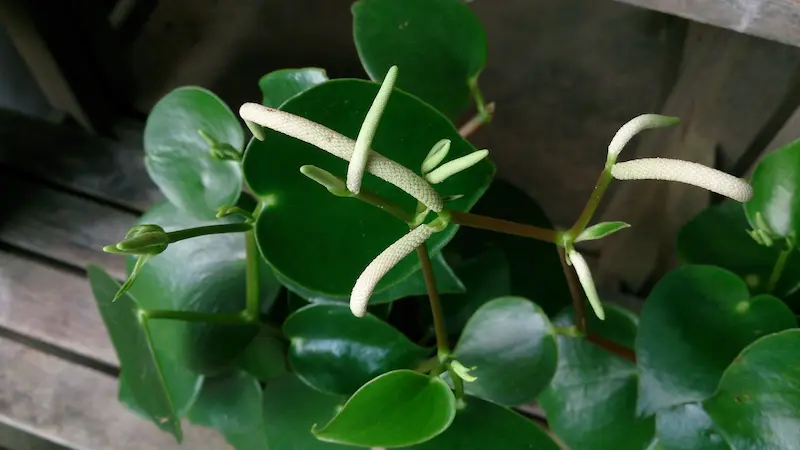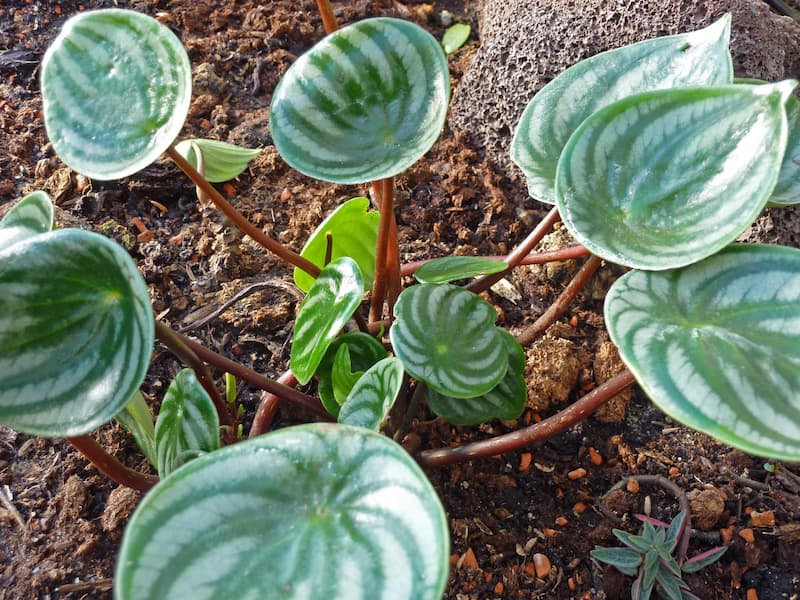Your cart is currently empty!
How To Care For The Beautiful Flowering Dogwood
In this article, we will focus mostly on these types of dogwoods and provide suggestions to help you select the right dogwood for your setting.
Your cart is currently empty!
The Peperomia plant is an easy care, versatile and recommended houseplant that that may be used in any room of the house. They are known for their succulent, heart-shaped leaves, which are both attractive and collectible. They have gorgeous leaves which appeal to those who want a colourful inside environment, and they also assist to purify the air. This plant has many rich varieties and a compact growth habit.
Peperomia obtusifolia is native to South America, Central America, the Caribbean and southern Florida. It is hardy to USDA zone 10, which means it should not be subjected to temperatures below 30 degrees Fahrenheit. They enjoy a warm and steamy atmosphere like tropical plants, especially during the summer months when their development is most active.
Peperomia are simple to cultivate in the home. They prefer warmth but do not require excessive humidity. They prefer bright lighting but do not require direct sunshine. Peperomias do not enjoy deep shadow on one hand or direct sunshine on the other; grow them somewhere in the middle. Temperatures in the summer range from 68 to 78 degrees Fahrenheit (20C to 25C). Temperatures should not fall below 50 degrees Fahrenheit (10C) in the winter.
Peperomia should not be overwatered. Watering every 7–10 days, depending on the time of year and temperature, should enough. Overwatering causes peperomias to decay at the root. I prefer to let the soil dry fully between waterings. This will substantially aid in the prevention of root rot. During the “growing” summer months, use a balanced liquid plant food every three waterings.
Peperomias, in general, do not require repotting. In fact, they perform better when under potted rather than over potted. However, repot when the plant outgrows its container. Use a well-draining soil (50 percent peat moss/50 percent perlite) while repotting.
Pruning may be necessary if the plant grows scraggly or out of control at any time of year. Pruning can be done anywhere along the stem.
In general, any of the 1,000 – generally slow growing – peperomias, as well as numerous cultivars, will only reach a maximum height of 10-12 inches. Some Peperomia types make excellent hanging plant specimens.
The long flower spikes are densely packed with small blooms that have no aroma.
Peperomia plant leaves, growth and foliage comes in many forms that are:
Peperomia propagation is as simple as snipping a tip, leaf, or stem cutting. Place the cutting in water or very light soil. Cuttings and leaves usually root fast. Once the roots are properly established, place them in pots with good rooting soil and you’re ready to go!
The soil is crucial in the rooting of peperomia. Because most peperomia plants have shallow root systems, they are good candidates for dish gardens. Use a well-drained soil with plenty of air. A basic and dependable soil mix for roots and growing peperomias is a 50/50 combination of peatmoss and perlite.
Like African violets, most peperomias will reproduce from leaf cuttings. Spring is the optimal period for propagation, although rooting can also be done in the fall.
According to the ASPCA, they are also non-toxic to dogs and cats.
Houseplants of tropical origin, such as Peperomias, prefer a higher humidity level of at least 40% relative humidity. In fact, they might not do well if the humidity falls below 40%. Water your plants first thing in the morning so they have time to dry before bedtime. Consider misting them. Mist their leaves on both sides, not just the top, to provide moisture. Also consider placing them in a terrarium.
According to NASA studies, one distinctive feature of Peperomia is that all of its leaf filters the air. According to the additional Wolverton’s Clean Air research, Peperomia decreases the quantity of formaldehyde inside by 47 percent, which is good to know because the material makes up a large percentage of indoor air. Other plants which clean the air are here.
These flower spikes have no negative effects on your plant. It’s better to leave them alone; they’ll stay put for a few months before dropping off on their own. The spindles or spikes you see are the plant’s blossoms, which will fall off naturally once they have finished blooming.
When a peperomia plant has dull looking leaves, it is usually caused from light which is too strong. Move the plant to more shade.
This condition usually happens from over watering. Allow the soil to dry out and avoid getting water on the leaves which can sometimes cause them to rot.
Your plant may be resting naturally and indicating this by losing the older leaves. If this is the case, reduce the frequency of watering and delay all fertilizer until new growth is seen. Consider whether it has been a long time since it has been repotted in fresh soil; now may be the time. Examine the plant’s base for possible rot: the tips of the stems where they connect to the plant’s base transform to watery, brown coloured mush.
Peperomias roots can decay when overwatered, especially in poorly draining soil. Your plant was raised in spongy, loose soil at initially. However, as time passes, the soil degrades into microscopic particles and compacts, reducing its ability to drain properly. Place a piece of newspaper on your kitchen table and tap the plant and soil out of the container if you suspect rot. Shake off the dirt and thoroughly clean the roots to determine which sections of the plant are dead and which are still alive. Using a sharp knife, extract the parts of the plant that haven’t yet perished.
There are a number of Peperomias to choose from, all of which offer different textures, hues, and leaf shapes. Some of the more popular variants include:

One of the most common peperomia species is Peperomia Caperata (emerald ripple), which has flower axils that resemble “mouse tails” (as do other peperomia plants). Its origins may be traced back to the Brazilian rainforest. The plant is cultivated as a little houseplant, standing no more than 8 inches tall, and is recognisable by its dark green wrinkled leaves and absence of “real” stalks. The little yellow-white blossoms appear on the “mouse tails” that rise above the crinkled, corrugated leaves (seen with a magnification lens). This variety has lovely heart-shaped leaves and foliage with a waffle-like texture. The striking, lush green foliage and stems have a silver and burgundy sheen to them.
Watermelon peperomia, Peperomia argyreia, is another popular variant, sometimes known as “baby rubber plants.” There are several advantages to having a stiff, upright habit. These are the hanging and spreading types, with a broad range of leaf designs. The leaves of this species are oval in form and have silver streaks. It may reach a height and breadth of eight inches if planted in a container large enough to allow for root growth. These plants have hanging leaves and grow in mounds.

This species comes in the shape of a dwarf specimen, which grows just four inches in height! “Pepper face” — A popular florist, green leaf, dish-garden plant with thick, cupped leaves that resemble rubber plants. Variegated, miniature, variegated miniature, albino, white-edged, and ‘Gold Tip’ variants are available, indicating that this plant sports freely. This infant rubber plant has a good stance. Some of these Peperomias have variegated leaves with gold and white colours, while others have solid, green, lustrous foliage.
Known as ‘Rainbow’ or ‘Tricolor,’ this plant has enormous medium green leaves with creamy white margins and rosy-pink flushes. Peperomia ‘Ginny,’ also known as ‘Tricolor’ or ‘Rainbow,’ is a popular peperomia houseplant and a highly delicate perennial. It features a strong stem with leaves that are green, cream, and crimson. On mature plants, ‘Ginny’ also features slender spikes of small white flowers that bloom all year. ‘Ginny,’ like most Peperomias, is easy to cultivate and may offer colour to your yard. Because of its big leaves and upright growth style, it grows well in pots. With its capacity to handle heat and shade, this plant may also be utilised as a groundcover.
Branching, red-tinged stems with pointed-oval, gray-green leaves divided by precise indented veins. The variegated form is dashingly splashed with creamy white.
Deep, dull-green pointed leaves with lighter veins; branches low and spreading.
Glossy gray-green leaves tapering to a point, on lax, thin stems. The variegated version sports a white border.
coin leaf peperomia – large green heart-shaped glossy leaves, and very easy to care for. Keep away from cold, allow the soil to dry between watering. The green glossy leaves are sometimes circular on young plants. Grow outdoors in USDA hardiness zone 10.
Tiniest trailer or creeper with threadlike stems stringing together perfect little blue button leaves, etched with a pattern of silver. This one may be reluctant to move about, takes a while to adjust to any new quarters.
Low creeper with dull bronze-green leaves indented with yellowish veins.
Sturdy trailer with glossy green, heart-shaped leaves.
Creeper or trailer with small pointed leaves marked deeply with parallel veins.
[…] Transform Your Home with Easily Care Peperomia Houseplants: A Guide […]
In this article, we will focus mostly on these types of dogwoods and provide suggestions to help you select the right dogwood for your setting.
Judith shares her secrets on getting her roses ready for winter, including using netting and snow cover. Discover just how she gets her roses prepped with her useful tips and tricks – even with her knee braces!
Learn about Stachys officinalis 'Hummelo' and 'Pink Cotton Candy', beautiful and low-maintenance plants attracting pollinators to your garden.
Create your own artistic masterpiece with topiaries! From vines to shrubs and even some herbs, get creative and find out which plants fit perfectly to your design. Prune and fertilize regularly and you’ll have a slow-growing living work of art in no time. Create a unique slow-growing living work of art in your backyard! Discover the endless options of topiaries, from vines to shrubs and even herbs, and learn how to prune and fertilize them to help them reach their full potential.
To try a cool crop planter, find a large pot and place it in partial shade. You can use seeds or seedlings. Watch for Gypsy moths.
Help plant the vegetables, keep the gardens weeded, then harvest the lush vegetables.
GardeningCalendar.ca gets some funding from advertisers. If you click on links and advertisements at no cost to you, the site may receive a small commission that helps fund its operation.
© 2025 J&S Calendars Ltd.
Leave a Reply
You must be logged in to post a comment.